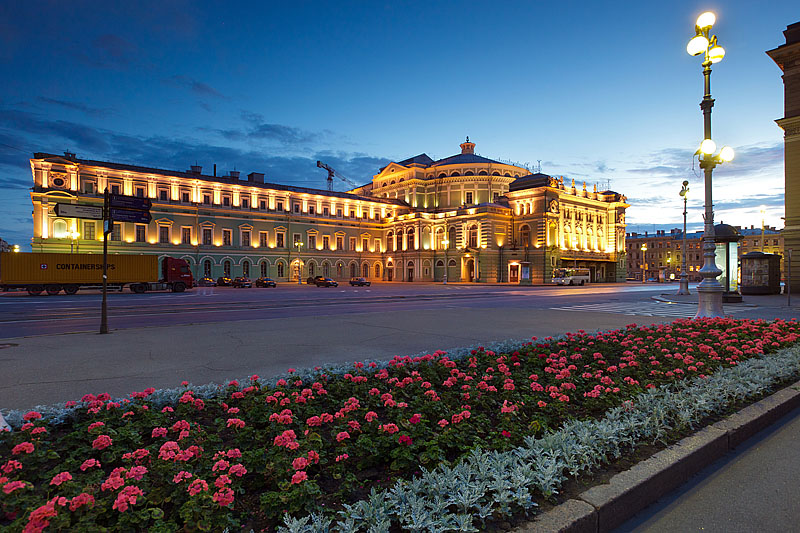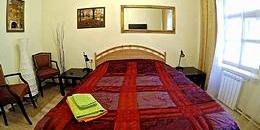Mariinsky Theatre
The Imperial Ballet and Opera Theatre had existed since 1783, performing on a variety of stages including the Maly ("Small") Theatre, a wooden building that used to stand near the Church of Our Saviour on the Spilled Blood, the private Hermitage Theatre, and from 1783 Antonio Rinaldi's Bolshoy Kamenniy ("Big Stone") Theatre on the site now occupied by the Rimsky-Korsakov State Conservatory, opposite the modern Mariinsky Theatre on Teatralnaya Ploshchad ("Theatre Square").
Rinaldi's building was enlarged and adapted by Thomas de Thomon 1802-1803, and further modified 1826-1836 by Alberto Cavos, the son of composer and conductor of opera Catarino Cavos, to allow the use of modern stage machinery.
In 1845, the touring circus of trick-rider Alessandro Guerra arrived in St. Petersburg, and the Italian soon persuaded the city authorities to allow him to erect a permanent wooden building for his performances opposite the Bolshoy Kamenniy Theatre. Guerra's exotic equestriennes and demonstrations of the art of Haute Ecole dressage (till then unknown in Russia) proved hugely popular with the beau monde of the city, launching an enduring passion for the circus among Russians. Nicholas I was quick to recognize the vogue, and soon brought circus art under state control, creating the Cirque de la Direction des Theatres Imperiaux, directed by Guerra's even more successful rival, Paul Cuzent of the Cirque de Paris.
By this time, beaten by Cuzent in the so-called "circus war" of 1846, Guerra had left St. Petersburg. In 1847, his building on Teatralnaya Ploshchad was demolished to make way for a new building by Alberto Cavos to house the Imperial Circus. Opened in 1849, this luxurious structure was far more theatre than big top, with a sumptuous foyer featuring gilded plasterwork, frescoes and chandeliers, and a large auditorium that had both a ring for equestrian performances and a stage for pantomimes.
In an attempt to live up to this magnificent space, Cuzent organized a series of grandiose spectacles - the first featured a Cossack troupe, a choir and 120 soldiers of the Imperial Army - that flopped spectacularly. After his resignation, the Imperial Circus never regained its initial popularity, and the building was used increasingly to stage drama and productions by the Russian Opera Company.
The Imperial Ballet Company and the Italian Opera Company continued to perform in the Bolshoy Kammeniy Theatre, but the building became increasingly dilapidated, and there were concerns about its structural soundness. When the Imperial Circus burnt down in January 1859, Cavos was instructed to build a completely stone replacement to be named after the wife of the new Tsar Alexander II, Empress Maria Alexandrovna - the Mariinsky Theatre.
Cavos retained the basic layout of the older building, but increased the height of the central structure. Like the Imperial Circus before it, the building was essentially neoclassical, but with elements of neo-byzantine design in its decorations. Inside, Cavos had been instructed by the Tsar himself to recreate the plush decorations of the Imperial Circus. Among the most impressive elements of the decor surviving from this period are the ceiling mural of a Clock with Cupids by Enrico Franciolli, and the spectacular fringed chandelier designed by Cavos.
The new Mariinsky Theatre opened 2 October 1862 with a performance of Glinka's A Life for the Tsar. Under Eduard Napravnik, who worked at the theatre for half a century, becoming Principal Conductor in 1869, the Mariinsky Theatre and the Russian Opera Company entered a golden age, premiering the great Russian repertoire of operas by Rimsky-Korsakov, Mussorgsky and Tchaikovsky.
The Imperial Ballet Company transferred to the Mariinsky Theatre in 1886, when the Bolshoy Kamenniy Theatre was finally condemned. By that time, the legendary Marius Petipa was Premier Maitre de Ballet, and it was on the stage of the Mariinsky that his classic choreography of The Sleeping Beauty, The Nutcracker and Swan Lake were first performed. At around the same time, Victor Schroter became chief architect of the Directorate of Imperial Theatres, and his work at the Mariinsky included restoration of the facades after fire damage in 1880, and large-scale reconstruction 1883-1896, during which period the auditorium that we can see today was created. In 1914, the Mariinsky's famous stage curtain, designed by Alexander Golovin, was installed.
In the Soviet era, the theatre was renamed in honour of assassinated local party boss Sergey Kirov, and the opera and ballet companies are still known by that name abroad. While the companies go from strength to strength under the artistic direction of Valery Gergiev, the theatre itself is in need of renovation. The last major refit of the building was completed in 1970 and, although the public areas are in excellent condition, the backstage areas are in a poor state of repair. However, when the theatre does eventually close for renovation, the company will have the use of the state-of-the-art Mariinsky Concert Hall, designed by French architect Xavier Fabre and opened in 2007, and the theatre's long-awaited second stage, under construction on the opposite bank of the Kryukov Canal since 2003.
| Address: | 1, Teatralnaya Ploshchad |
|---|---|
| Metro: | Admiralteyskaya, Sadovaya / Sennaya Ploshchad / Spasskaya |
| Getting there: | The Mariinsky Theatre is some distance from the metro. To walk from Sadovaya, Sennaya Ploshchad or Spasskaya metro stations takes around 20 minutes. Walk south from Sennaya Ploshchad down Sadovaya Ulitsa, and take the second turning after the square on the right onto Prospekt Rimskogo-Korsakova. Follow the avenue over the Griboedov Canal and take the first turning on the right onto Ulitsa Glinki (opposite the St. Nicholas Cathedral). It is then about 150m to Teatralnaya Ploshchad and the Mariinsky Theatre. If you are coming from Nevsky Prospekt, it is easier to take a bus (27) or trolleybus (3 or 22), from the north side of the street (odd numbers). The ride direct to the theatre will take around 15 minutes. |
| Telephone: | +7 (812) 326-4141 |
| Website: | https://www.mariinsky.ru/en/ |
| Order tickets: | https://www.mariinsky.ru/en/playbill/playbill/ |
| What's nearby? | Kryukov Canal, Rimsky-Korsakov State Conservatory, Ulitsa Dekabristov, St. Nicholas Naval Cathedral |
























